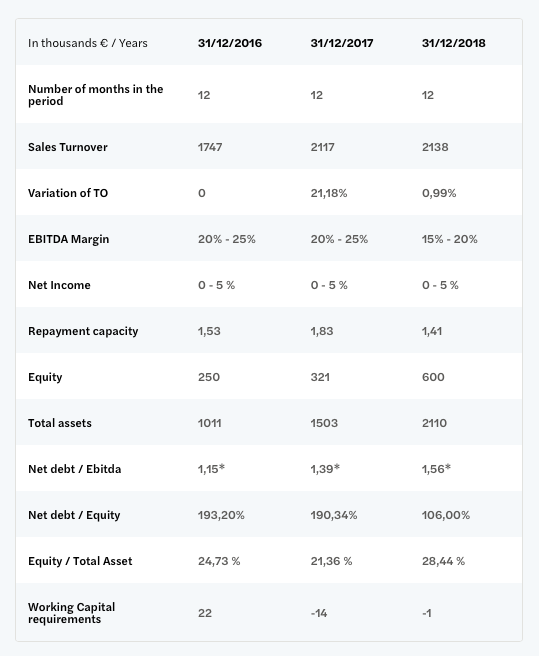With crowdlending, you’re in control. You decide which SMEs and which projects you support with your loan. However, with crowdlending it’s not just about supporting companies. The return on your investment is also important. Therefore, it is essential to read a project description and to make a conscious choice to lend to a company (or not). In this blog you can read how analysing the financial health of a company can help you make the right choice.
Selecting good projects
A company’s past results provide an indication for the future results. Therefore, the financial results of a company can help you in your project selection.
To present the financial results in a clear and understandable way, we use a standard format for each project in the form of a table. You can best see this table as a summary of a company’s balance sheet and profit and loss account over the past 3 years. On the basis of this information, we also calculate three ratios, which we will explain later on.
This information together gives a complete insight into the financial health of a company:

The basis of the financial analysis
It is good to start at the basis of the financial analysis. These are EBITDA (earnings before interest, tax, depreciation and amortisation), net income, equity and net debt:
- EBITDA: a company’s income before interest, taxes, depreciation and amortisation. The EBITDA provides a focussed insight into a company’s actual revenues. This also makes it easier to compare different companies. The higher the EBITDA, the better.
- Net result: the net result provides insight into the profitability of a company, thus whether it is making money for its shareholders. If it’s not, then the company has no future prospects in the long run. Therefore, we only finance profitable companies. The net result can be paid to its shareholders in the form of a dividend or withheld. In the latter case, it is added to the equity.
- Equity: the part of the capital that is contributed by the owners. Equity consists of (share) capital, reserves and retained earnings. A higher equity means that a company has a larger buffer to absorb setbacks. At October we do not finance companies with negative equity.
- Net debt: the net debt is a company’s total debt minus cash. It gives a picture of the actual debt of the company. The cash and cash equivalents can compensate a part of the debt. When the net debt is negative, the company has more cash than financial liabilities.
Three important financial ratios
We use financial ratios to review and place in perspective the company’s financial results. The three financial ratios we use are:
- Net debt to EBITDA: this ratio is widely used in the financial sector. The ratio is easy to use and quick to calculate. It measures a company’s ability to repay its debts on the basis of its EBITDA. It indicates in how many years a company can repay its debt, when it uses the full EBITDA to do so. For the company in the example above, it would take 1.56 years to repay its existing debt, based on the 2018 figures. The lower this ratio, the better. At October, we do not finance companies with a net debt/EBITA ratio higher than 5.
- Net debt to equity: also called the gearing ratio. It measures a company’s dependence on external financing. In our example, net debt represents 106% of equity in 2018. The lower the ratio, the better the financial health of the company. At October, we do not finance companies with a net debt/EBITA ratio higher than 300%.
- Equity/balance sheet total: In our example, equity represents 28.44% of the balance sheet total in 2018. A higher ratio is better, because it shows that the owners of the company themselves have contributed a considerable amount of money. It also indicates the extent to which setbacks in the result can be absorbed.
The new loan that the company acquires through October influences these ratios. That is why in the project description we also provide the ratios including the October debt.
The credit analysis
The financial results of a company do not tell the whole story. Other factors, such as the market in which the company operates and management also play an important role. These factors are also taken into account in the credit analysis of a project. Want to know more? Read more about the credit analysis at October.